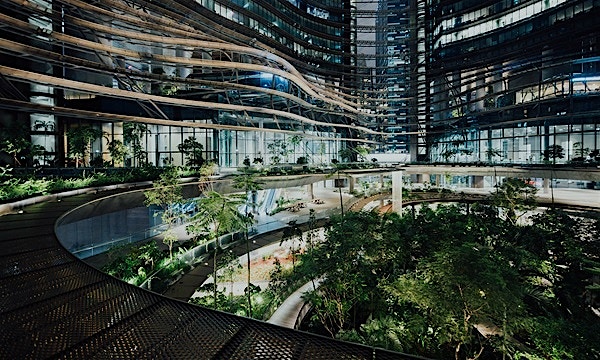The Philippines is about to join the World Economic Forum’s Blue Carbon Action Partnership to accelerate the restoration and conservation of coastal ecosystems.
Announcing this at COP28 recently, Secretary of the Department of Environment and Natural Resources of the Philippines, Antonia Loyzaga, said: “The Philippines, endowed with rich biodiversity and extensive coastlines, is home to vast blue carbon ecosystems. We look forward to working with the Blue Carbon Action Partnership to facilitate the inclusive, whole-of-society approach to developing a shared ambition for blue carbon.”
Additionally, Loyzaga mentioned that this will help in “community resilience, inclusive development and unlocking the Philippines’ potential to provide nature-based climate solutions for the rest of the world while supporting our programs for protected areas and preparing the country for participating in the new blue economy.”
A philanthropic yet failed attempt
After Super Typhoon Yolanda wreaked havoc in the Philippines’ coastal communities in 2013, the government started an initiative to plant a million mangroves. However, as a result of being unaware of the right species depending on the geographic and climatic conditions, many of those saplings died.
Spread across at least 136 countries, there are over 70 species of mangroves that form forests and cover just 0.1% of the Earth's surface. Each species is uniquely suited to its blue carbon ecosystem (BCE), which varies and blends with geographical conditions.
What is a blue carbon ecosystem?
Mangroves, tidal marshes and seagrasses are part of the blue carbon ecosystems that store up to five times more carbon per acre than tropical rainforests. If their carbon storing capacity is compared to terrestrial forests (per hectare), the amount is 10 times greater.
A square mile of these plants and trees has the capacity to hold as much carbon as the annual emissions of 90,000 cars.
Additionally, creating natural barriers between the oceans and coastal communities and giving a coastline its natural shape, mangroves protect against rising natural calamities like cyclones, tornadoes, typhoons, tsunamis and coastal erosion.
Their strong and exposed roots significantly reduce the impact of storms and rising water levels of seas up to 50 centimeters per kilometer of mangrove width. Mangrove roots shelter young corals and protect them from bleaching. The existence of corals on seabeds naturally keeps the seawater cool and prevents it from warming up.
Home to a thousand species of fish, birds, crabs, turtles and other marine creatures, mangroves are the framework for the blue carbon ecosystems and are indispensable in preserving biodiversity and food security for millions of coastal communities.
Scary figures
However, blue carbon ecosystems are at high risk and disappearing at a rapid rate. A report by Conservation International mentioned that up to 67% of mangroves, 29% of seagrass meadows and at least 35% of tidal marshes have already been lost.
Each year, an estimated 840,000 to 2.4 million acres of blue carbon ecosystems are lost. Annual loss of blue carbon-rich ecosystems is likely to release the equivalent of 0.15–1.02 billion tons of CO2 annually. If compared, these emissions will be equal to roughly 206 million gasoline-powered vehicles driven for one year, the report added.
Reasons behind the disappearance
Besides the rising number of natural disasters caused due to climate change, there are a variety of human interferences responsible for the fast disappearance of the blue carbon ecosystems.
Some of these are coastal development, shrimp aquaculture, charcoal farming, agriculture and harvesting, palm oil plantation, exposure to harmful fertilizers and pesticides from nearby agricultural lands.
Additionally, land encroachment, urban development, release of chemicals and oil spills from factories, plastic pollution in oceans that shore up on mangroves roots, accumulation of plastiglomerate, wide range of tourism, hydraulic interventions and use of mangrove timber to create jetties, boats, houses and sustainable submersible structures used in fishing are major reasons behind the disappearance of the mangroves.
Conservation and protection
Of late, there has been increasing demand for blue carbon ecosystem restoration and conservation to attain its multifaceted benefits.
After the pact with Indonesia last year, the Philippines partnership at COP28 is the second. These two nations house four trillion tons of carbon in their BCEs — the carbon equivalent of over 11 trillion barrels of oil. With nearly 20% of the mangroves in Indonesia alone, South-East Asia is home to almost one-third of mangroves globally.
It’s expected that the newly launched partnership with the Philippines will support high-quality blue carbon action that will impact nearly 700 billion metric tons of carbon sequestered in mangroves and seagrasses in the country.
“Coastal ecosystems such as mangroves are critical to life in the ocean and to those who live alongside it. Increasingly, we are also recognizing their vital role to buffer us against the worst effects of the climate crisis,” said Alfredo Giron, Acting Head of the Ocean Action Agenda and Friends of Ocean Action at the World Economic Forum.
“When blue carbon benefits are recognized and valued by governments and businesses, who commit and invest in the restoration of mangrove, seagrass and salt marsh ecosystems around the world, everybody wins – people, nature, climate and ultimately, the planet,” added Giron.
Other Good Samaritans
The Global Mangrove Alliance is a comprehensive, coordinated, global approach to mangrove conservation and restoration at scale. Since its launch in 2018, it has worked with governments, technical experts, civil society organizations, local communities, businesses, funding agencies and foundations to halt loss, restore half of recent loss and double protection of mangroves globally by 2030.
The Mangrove Alliance for Climate is an intergovernmental alliance that was initiated by the UAE and Indonesia in COP27 and was later joined by India, Sri Lanka, Australia, Japan and Spain. With no binding targets, the participants work on a voluntary basis and set their own targets such as commitments to plant saplings, spread awareness on benefits of mangroves, share expertise and support each other in researching, managing and protecting coastal areas.
The International Partnership for Blue Carbon is a global network of 54 governments, NGOs, intergovernmental organizations and research institutions focused on blue carbon ecosystems through learning and knowledge-sharing. It works to increase international commitments to protect coastal blue carbon ecosystems, improve national policies to protect coastal blue carbon ecosystems and accelerate on-the-ground implementation of blue carbon protection and restoration activities.
The Blue Carbon Initiative is a coordinated program that brings together governments, international research institutions and NGOs. With a focus on conserving and restoring global coastal ecosystems for the climate, biodiversity and human wellbeing, it advances the management approaches, financial incentives, policy mechanisms and sustainable use of blue carbon ecosystems as tools for climate change mitigation.
Apart from these valuable players, there are other organizations concerned about the climate and contributing to the blue carbon ecosystems as part of their corporate social responsibility (CSR) activities. For example, HCLFoundation’s Plogathon drive recently.
“We believe that genuine transformation begins at the grassroots level, with communities taking ownership of their coastal ecosystems. Through the Plogathon campaign, we seek to not only remove waste but also to instill a profound sense of responsibility toward the oceans that sustain us,” said Dr Nidhi Pundhir, Vice President, Global CSR, HCLFoundation.
HCLFoundation’s coastal and marine conservation efforts helped raise 608,100 mangroves saplings for plantation, collect 115,487 kg ghost nets, release 300,000 turtle hatchling and rescue more than 200 mega-fauna including turtles, dolphins and whale sharks entangled in ghost nets.





